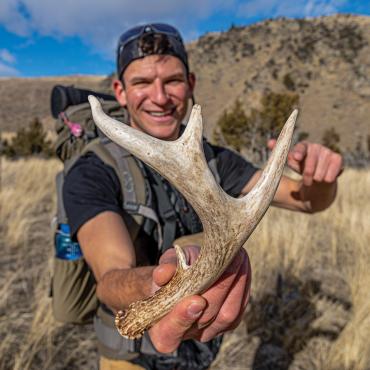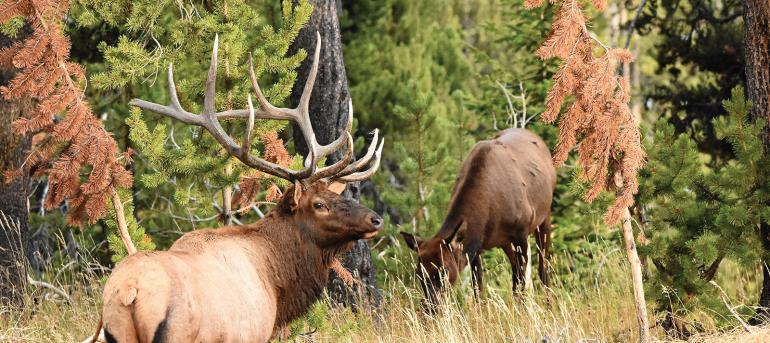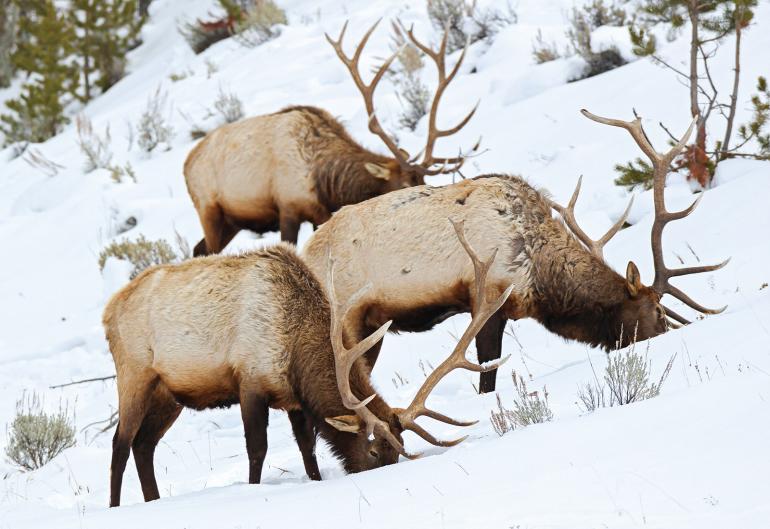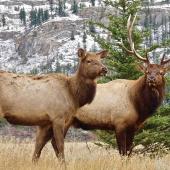King of the Hills
Elk hunting in southwest Montana.
Of all the game species in Montana, elk are far and away the most sought-after. For those looking to challenge themselves mentally and physically, to test their patience and woods-sense, to become intimately acquainted with the forest and its creatures, elk hunting is the gold standard. Whether on the plains or in the mountains, with a rifle or a bow, during the rut or a late-season blizzard, there are countless tactics and methodologies with which to pursue this iconic animal. The following is an overview of elk hunting in this state—but it’s just the bare bones. People spend their whole lives chasing elk, and the only way to truly learn about them is to log long hours in the woods, looking, listening, smelling, and thinking. Use this only to guide your own foray into elk hunting.
Habitat
From sagebrush flats to high-alpine basins, elk are ubiquitous throughout Montana. Narrow down the type of terrain you’d prefer to hunt, and go from there. If spot-and-stalk hunting from the road is your thing, consider a late-season hunt once snow and hunting pressure have pushed elk into lower elevations. If you prefer to spend time in the high country, you’ll find elk there as well, albeit earlier in the season. Just like any other animal, they need food, water, and shelter to survive. Find a combination of the three on a map—Google Earth satellite imagery is an invaluable tool—and there are likely to be elk visiting that location at some point in the season.
Behavior
Elk behavior is fairly predictable through the rut in September, and into mid-October. Most elk drop into thick timber during the rut, so focus efforts on clearings or meadows surrounded by cover. Bulls are extremely vocal this time of year, so locating them shouldn’t be an issue—if you’re in a good area, that is. Getting within arrow range, however, is a whole different story, and is something that can only be learned from trial and error in the field.
Come rifle season, there are two main considerations for elk behavior: weather conditions and hunting pressure. Both are significant drivers of elk movement and should be used to your advantage rather than dreaded.
Generally speaking, elk remain at higher elevations until their preferred food is inaccessible due to snow. In Montana this is typically mid-November. Snowstorms in September or October are of little importance—elk have no problem kicking snow off their forage grasses, or finding melted-out, south-facing slopes. But come November, once a few storms have deposited a significant layer of snow in the high country, they’ll start moving to lower terrain. Alternatively, hunting pressure can drive elk from their preferred haunts and into remote hideouts, or onto private land. Whether it’s pressure or snow pushing elk around, locate migration corridors and game trails, and stake out these spots for elk on the move.
Gear
Search “elk hunting” on the internet, and you’re sure to be bombarded by a litany of ads, all using elk antlers to sell you high-end gear—be that a backpack, spotting scope, or a $500 pair of binoculars. Tune it all out. It’s all accessory. Other than a good pair of boots, a knife, a load-hauling backpack, and a firearm (or bow), you really don’t need anything else—although a decent set of binos are immensely helpful. Beyond these essentials, the best way to consistently shoot elk is to spend time in the woods. The folks I know who punch their tags every year spend weeks or even months in the woods. Granted, most of them are seasonally employed and have the luxury to scout extensively before opening day, but the point remains the same: you can’t purchase an elk with gear. Put boots on the ground, as many days as possible—in and out of season. Learn as much as you can by observation and, come opening day, you’ll have a leg up on pursuing the ghosts of the forest.
Bow vs. Rifle
The choice between a boomstick and a bow boils down to what you want out of the experience. If a mid-September backpacking trip, or screaming, rutting bulls at close range is what you’re after, then notch an arrow. If tracking elk through the snow or staking out a migration route with a fire and a pot of coffee is more your speed, then grab a rifle. All else aside, however, if you’re looking to harvest an elk, a rifle will be far more effective than a bow. Being able to shoot out to 200 or 300 yards is a game-changer. Keep in mind, though, that you can hunt elk at close range with a rifle, too. On one of my most memorable stalks during rifle season, I crept to within 10 yards on a bull bedded high in an avalanche chute. I didn’t get a shot off, but it was a learning experience—rifle hunting can be done at close range, often requiring strategic stalks though open country. For me, that’s addicting enough to spend September getting in shape for rifle season.
Pack-Out
Make no mistake here: elk are big creatures. I’ve been shocked time and time again by just how massive they are when I walk up on a fresh kill. But with appropriate planning, the “oh shit” moment can be extirpated altogether. Making a game plan ahead of time is paramount. This can be anything from “all-hands-on-deck, we gotta get this thing out right now” on a hot day during bow season, to “let’s hang ’er in a tree and keep hunting” on a cold day. If the conditions are appropriate, and it’s well below freezing at night, properly-hung meat can sit for a week—or longer.
Count on four or five pack-loads for a properly-dressed elk; up to six for a big bull, especially if you have antlers and a skull to extract. The importance of a high-quality pack cannot be overstated—a well-built load-hauler will double both capacity and comfort. Regardless, you’ll need to plan accordingly. Depending on where you’re hunting, that might mean having a “last bullet” or “last arrow” cut-off time (or day) before you have to be back in town. It’s always good to leave a little wiggle room, too, in case you don’t get a clean shot and need to track a wounded animal. It happens, despite our best efforts and the best-laid plans, especially with archery hunting. On that note: don’t give up too easily. Even if you lose the track altogether, any dog with a halfway decent nose can pick it up and may just take you right to your dead elk.
Finally, having a pack-mule team (also known as friends) on call can be a lifesaver once an elk is on the ground. Remember, though, it goes both ways. If you plan to rely on friends, then you’d better be ready to drop everything and shoulder a pack when you get the same phone call from one of them. If your employer is worth a damn, and familiar with Montana customs, he or she should have no problem with you calling in last-minute or taking off early to help with a pack-out.
Rut
Diehard bowhunters live for the rut, and for good reason. Throughout the month of September, bulls congregate herds of cows and defend them from competition at all costs. It’s tough to beat the adrenaline rush of screaming bulls at close range—800 pounds of angry, sex-crazed ungulate, with multiple spear-points on its head, coming in hot to within 30 yards—it’s enough to make a hard man humble. Aside from a few exceptions (such as parts of the Bob Marshall Wilderness and a section of ground deep in the Beartooths), elk in the rut can only be targeted with bows or muzzleloaders. Calls are important here; a good bugle and cow call should be in your pack or pocket at all times. Watch videos online to learn the basics, and listen to actual elk to refine your technique.
Regs
Montana has the most generous over-the-counter general-season regulations in the West, with a nearly six-week bow season and a five-week rifle season open in most units in southwest Montana. Barring major regulation changes, elk hunters in Montana could harvest a bull or a cow every year of their lives without ever needing to put in for limited-entry tags. As usual, check FWP regulations for exact season dates and regulations.












